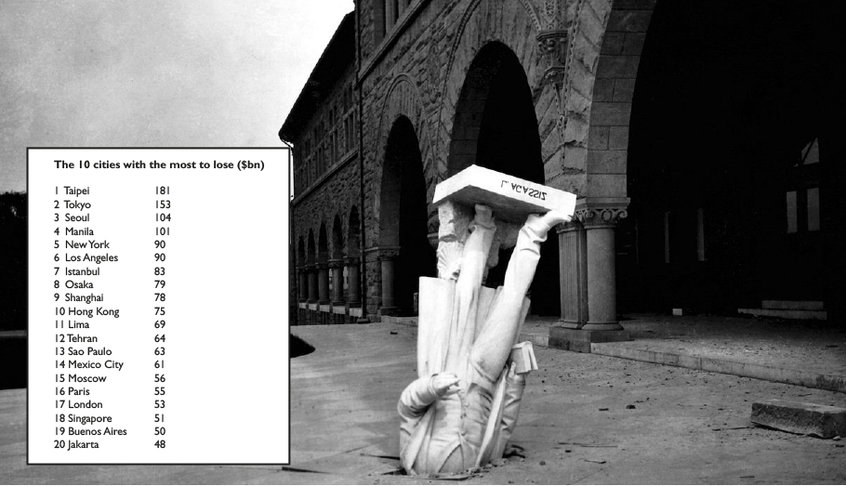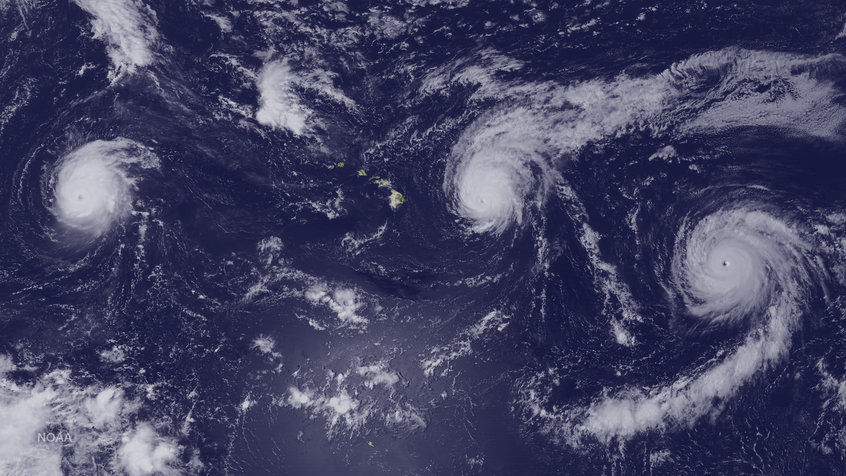The world’s 301 largest cities have a total of $4.6 trillion at risk from man-made and natural disasters over the next 10 years, according to a new report by the London insurance market, Lloyd’s.
Cities in the Asia-Pacific region carry the greatest liabilities, with seven of the 10 most at-risk cities located in Japan, Taiwan, Korea, China and the Philippines.
But New York and Los Angeles are also in the top 10, while Paris, Moscow and London take their places in the top 20 riskiest places to live.
And despite the increasing risks posed by global warming, the most expensive threat of all was found to be financial – the stock market crash.
Researchers found that the most expensive threat, totalling $1 trillion, was posed by a market crash. The next greatest was a pandemic, followed by hurricanes and typhoons, earthquakes and floods–
The Lloyd’s City Risk Index 2015-25 analysed the threat to cities’ economic output from 18 sources of disaster.
The city with most to lose is Taipei, according to the report. A full half of its GDP is at risk from disaster – $81bn from typhoons, $30bn from earthquakes and $11bn from floods.
The next most vulnerable was Tokyo, which is menaced by typhoons ($29bn), market crashes ($23bn), oil price shocks ($21bn), earthquakes ($19bn) and floods ($18bn).
About $1.69 trillion of the GDP at risk is in the southeast Asia, where cities in Cambodia, Indonesia, Malaysia, Myanmar, Philippines, Singapore, Thailand and Vietnam are seen as exposed to risks, partly as a result of their exposure to violent tropical weather, seismic activity and market volatility.
The greatest threats to the 15 cities most at risk is from typhoons ($68bn), followed by market crash ($61bn), pandemic ($3bn), earthquake ($30bn), and flood ($22bn).
Although relatively developed Asian cities have most to lose, the bulk of the liability is being born by emerging economies – more than 70% of the total.
The report notes that this is partly a result of their high levels of growth in recent years, coupled with a lack of resilience.
“Cities are often highly exposed to single natural catastrophes,” the report notes. “Earthquake alone represents more than 50% of both Lima’s and Tehran’s total risk, for example.”

The San Francisco earthquake of 1906 destroyed 80% of the city and killed about 3,000 people. The cost is estimated to have been $10.5bn in 2015 dollars
Away from tropical storms and tectonic plates, the principal threats are man-made: the two European cities with most to lose, Paris and London, are overwhelmingly threatened by economic dangers – market crashes, oil price shocks and cyber attacks, with flooding and pandemics the only danger posed by the nature. Â
Among all the cities, the researchers found that the most expensive threat, totalling $1 trillion, was posed by a market crash. The next greatest was a pandemic ($590bn), followed by hurricanes and typhoons ($587bn), earthquakes ($465bn) and floods ($432bn).
The threat of hurricanes and droughts have been made more severe by global warming in general, and in particular the increasing prevalence of El Niño events – areas of warm water in the southern Pacific.
This year, the temperature of the Pacific is about 2°C higher than normal, making it one of the strongest El Niños on record. This is likely to lead to more tropical storms in the Pacific, less rainfall in India, Indonesia, Australia, and floods in the Americas.

The strongest ever El Niño has led to the first observed case of three “extreme hurricanes” in the Pacific at the same time (Source: NASA)
Altogether, half of the GDP is at risk as a result of natural disasters and half as a result of human activity, and some of the natural threats, such as a plant epidemic or a human pandemic, are exacerbated by globalisation.
To deal with these dangers, Lloyd’s advocates increasing the resilience of the built environment and taking out more insurance.
The report notes that “In principle, about half of the total risk can be protected by improving aspects of all cities’ infrastructure and crisis management, with insurance playing a key role in this process.”
Inga Beale, the chief executive of Lloyd’s, comments in the executive summary: “Research shows that a 1% rise in insurance penetration translates into a 13% reduction in uninsured losses and a 22% reduction in taxpayers’ contribution following a disaster.”
The calculations are based on research by the Cambridge Centre for Risk Studies and the Judge Business School at the University of Cambridge.
Top photograph: The aftermath of Hurricane Ike on the Bolivar Peninsula in Texas, 2008 (Jocelyn Augustino/FEMA)






